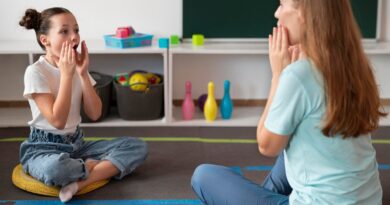Factors to consider to measure identify learning disabilities?
Learning disabilities are a type of neurodevelopmental disorder. Learning disorders are brain differences that affect a person’s ability to read, write, communicate, do math, and perform other similar skills. Different groups may define “disabilities” differently, often based on the organization’s mission. Having a learning disability, or even several deficits, is not associated with intelligence.
It simply indicates that the person’s brain functions differently than others. In many circumstances, interventions—treatments—can assist a person with learning difficulties in reading, writing, speaking, and calculating just as well or better than someone without these disabilities.
Learning difficulties are neurological conditions that impair the brain’s ability to receive, process, store, and react to information. Specific learning disabilities (SLD) include dyslexia, dysgraphia, dyscalculia, and other learning disorders.
They can impact reading, writing, math, reasoning, and other skills necessary for learning. Here are the main types:
1. Dyslexia (Reading Disability)
• Difficulty with reading, spelling, and understanding written words
• Trouble recognizing letter sounds and blending them into words.
• May read slowly and struggle with comprehension.
2. Dysgraphia (Writing Disability)
- Difficulty writing, spelling, and organizing thoughts on paper.
- Poor fine motor skills,make writing physically difficult.
- Sentences may be incomplete or disorganized.
3. Dyscalculia (Math Disability)
- Difficulty understanding numbers, math facts, and calculations.
- Trouble recognizing number patterns or performing mental math.
- Struggles with telling time, measuring, or handling money.
4. Auditory Processing Disorder (APD)
- Difficulty processing and interpreting sounds.
- Trouble distinguishing similar sounds, especially in noisy environments.
- May struggle with following verbal instructions.
5. Visual Processing Disorder (VPD)
- Difficulty interpreting visual information.
- Trouble recognizing shapes, letters, or patterns.
- Struggles with spatial relationships and organization.
6. Nonverbal Learning Disability (NVLD)
- Strong verbal skills but difficulty with nonverbal cues (body language, facial expressions).
- Struggles with spatial awareness, coordination, and organization.
- Difficulty understanding abstract concepts and problem solving.
7. Dyspraxia (Motor Skill Disability)
- Impaired motor coordination, making tasks like writing, tying shoes, or using tools difficult.
- Clumsiness and poor hand-eye coordination.
- May struggle with speech and pronunciation.
Each type of learning disability can vary in severity, and individuals may have more than one. Early diagnosis and tailored interventions (such as specialized teaching methods, assistive technology, and therapy). Some therapies, like CBT, articulation therapy, occupational therapy, speech & language therapy, and art therapy, can help improve learning outcomes.
Measuring identity in individuals with a learning disability requires a multidimensional approach that considers cognitive, emotional, social, and self-perception factors. Here are some key factors to consider:
1. Self-Concept & Self-Perception
- How the individual views their abilities and limitations.
- Level of self-confidence and self-worth.
- Emotional reactions to challenges and failures.
2. Social Identity and Belonging
- Sense of belonging in peer groups, family, and society.
- Impact of learning disabilities on social relationships.
- Experiences of stigma, discrimination, or acceptance.
3. Academic & Cognitive Identity
- Awareness of one’s learning strengths and weaknesses.
- Attitudes towards education and learning experiences.
- Motivation and persistence in academic settings.
4. Emotional and Psychological Well-being
- Levels of stress, anxiety, or frustration due to learning difficulties.
- Coping mechanisms and resilience.
- Presence of co-occurring mental health conditions like depression or low self-esteem and low self-confidence.
5. Family and Cultural Influences
- How family and cultural background shape identity formation.
- Expectations and support from caregivers.
- Influence of cultural beliefs about disabilities.
6. Communication & Expressive Identity
- Ability to articulate thoughts and emotions effectively.
- Challenges in verbal or non-verbal communication.
- Sense of agency in expressing personal choices.
7. Behavioral and Adaptive Functioning
- Independence in daily activities.
- Ability to advocate for oneself and seek help when needed.
- Adaptation to new situations and problem-solving skills.
8. Career & Future Aspirations
- Perception of career possibilities and self-efficacy in work environments.
- Support systems for career development and vocational training.
- Barriers and facilitators to achieving personal goals.
9. Peer Comparisons and Social Influence
- How individuals compare themselves to peers.
- Influence of social media and external expectations.
- Internalized beliefs about intelligence and success.
10. Identity Development Across Life Stages
- Changes in self-perception from childhood to adulthood.
- Impact of life transitions (e.g., school-to-work transition).
- Ongoing identity negotiations based on new experiences.
Conclusion
Measuring identity in individuals with a learning disability requires a holistic approach that considers cognitive, emotional, social, and cultural influences. Identity formation in such individuals is shaped by self-perception, academic experiences, social relationships, emotional well-being, and environmental factors such as family and societal expectations.
It is essential to assess not only the individual’s awareness of their learning strengths and challenges but also their sense of belonging, self-esteem, and self-improvement. Factors like adaptive functioning, career aspirations, and communication skills further contribute to understanding their evolving identity.
A comprehensive evaluation should include self-reports, observational methods, psychological assessments, and input from caregivers or special educators. This multidimensional perspective allows for better understanding of how individuals with learning disabilities perceive themselves and navigate their personal and social worlds. Identifying these factors can help in designing personalized interventions, fostering self-acceptance, and promoting inclusive environments that support identity development and overall well-being.
Reference
- Baum, S. M., Schader, R. M., & Owen, S. V. (2017). To be gifted & learning disabled: Strength-based strategies for helping twice-exceptional students with LD, ADHD, ASD, and more. Prufrock Press.
- Foley-Nicpon, M., & Assouline, S. G. (2015). Counseling considerations for the twice-exceptional client. Journal of Counseling & Development, 93(2), 202–211.
- Maddocks, D. L. S. (2020). Cognitive and achievement characteristics of students from a national sample identified as potentially twice exceptional (gifted with a learning disability). Gifted Child Quarterly, 64(1), 3–18.
- Reis, S. M., & Renzulli, J. S. (2004). Current research on the social and emotional development of gifted and talented students: Good news and future possibilities. Psychology in the Schools, 41(1), 119–130.



